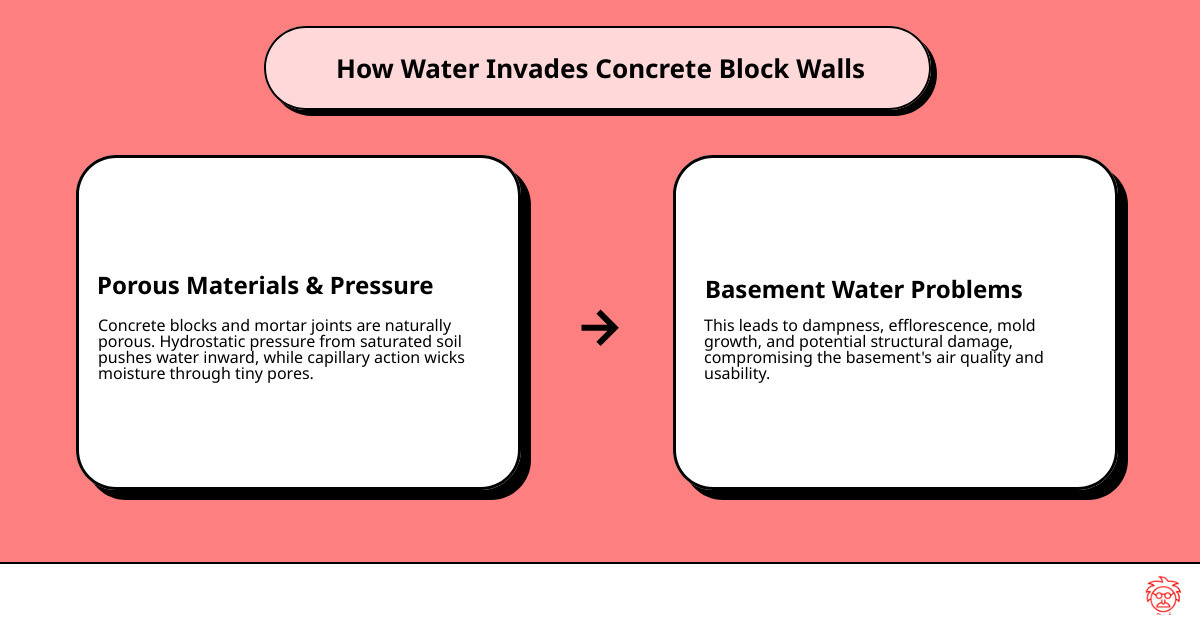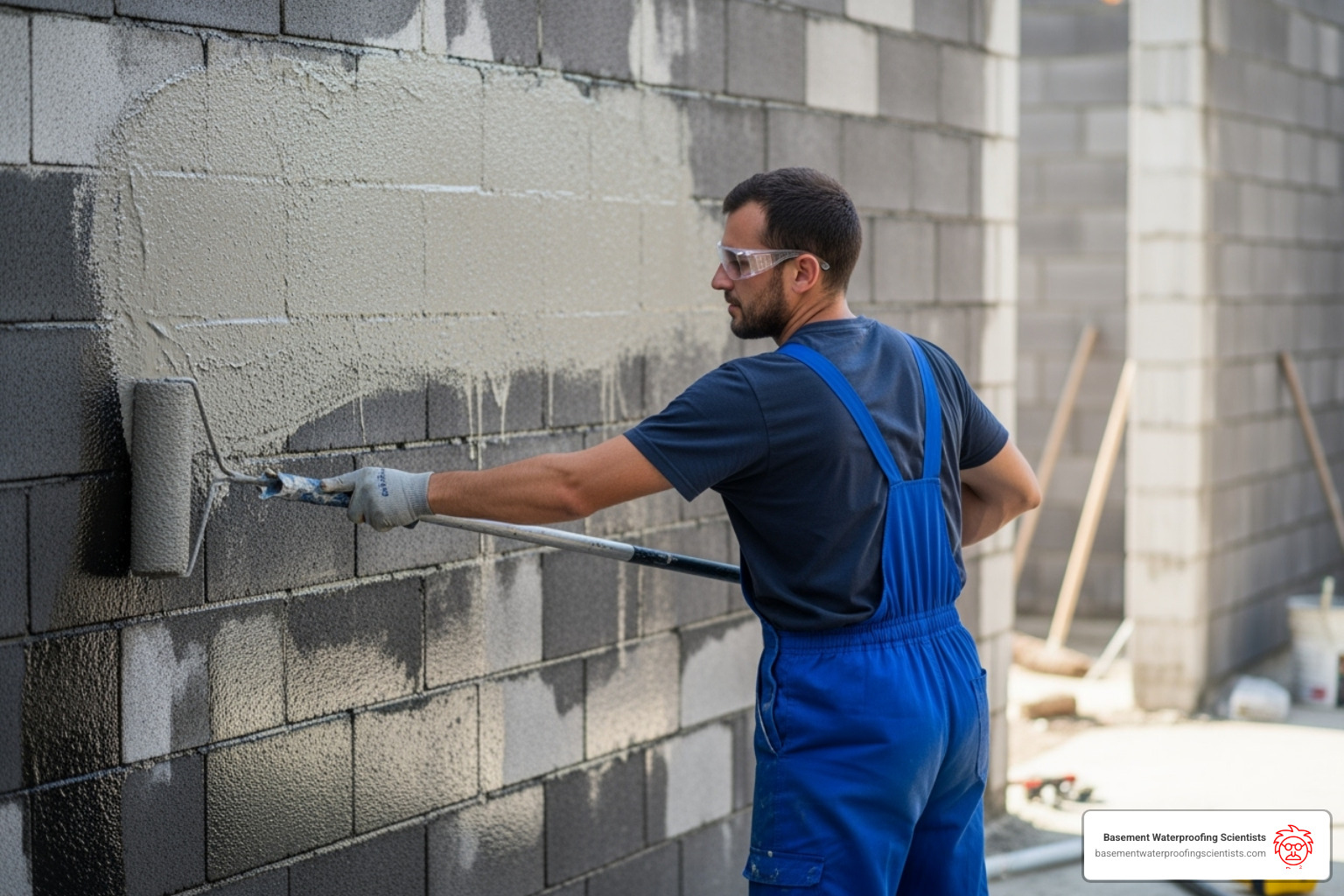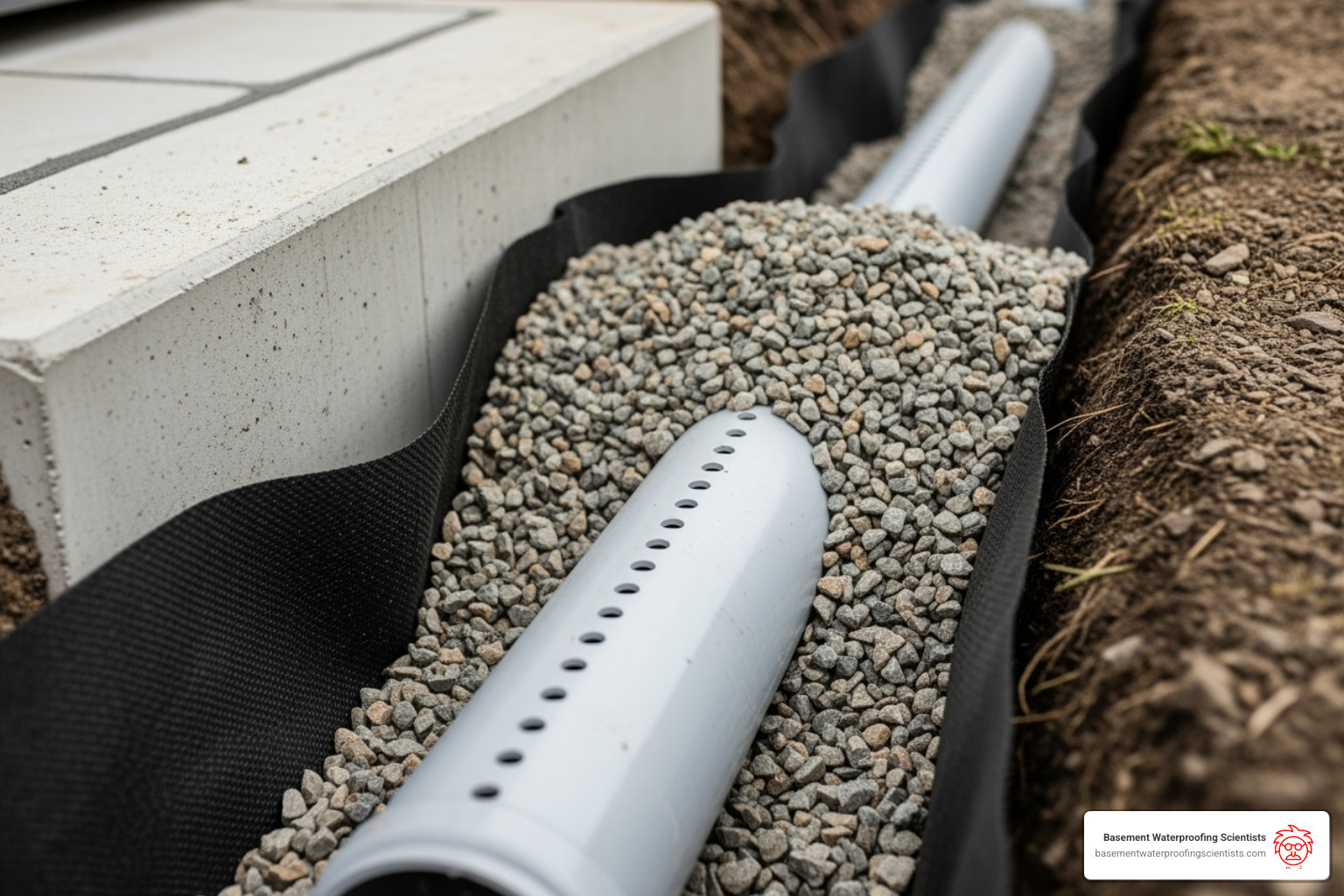The Key to a Dry Basement: Concrete Block Wall Waterproofing
If you’re dealing with a wet concrete block basement, here’s a quick look at how to waterproof it effectively:
- Identify and repair cracks: Seal any visible cracks or voids in the wall.
- Apply waterproofing membrane: Use a suitable liquid or sheet membrane.
- Install drainage system: Manage water pressure with interior or exterior drains.
- Address external factors: Ensure proper grading and guttering around your home.
Concrete block wall waterproofing is crucial for keeping your basement dry and your home safe. Concrete blocks are a common choice for foundations. But they have a secret vulnerability: they are porous. This means water can easily seep through them and their many mortar joints.
Without proper waterproofing, you risk constant dampness, mold growth, and even structural damage. Keeping water out protects your investment. It also creates a healthy, usable space downstairs.
I’m Darin Garvey, with Basement Waterproofing Scientists. My experience covers over 30 years of detecting leaks and delivering reliable, customized solutions for concrete block wall waterproofing.

Why Concrete Block Walls Are Vulnerable to Water
Concrete block walls are a common cause of wet basements. While durable and budget-friendly, their nature makes them susceptible to water intrusion for several reasons:
- Porosity of concrete: Concrete blocks are inherently porous. A typical block is significantly more permeable (around 3.2 perms per inch) than a solid poured concrete wall (around 0.3-0.4 perms), allowing moisture to pass through easily.
- Mortar joints: A block wall has numerous mortar joints that are weaker than the blocks themselves. They can crack or deteriorate over time due to natural settling, creating pathways for water.
- Hollow cores: Many blocks have hollow centers that can fill with water. This trapped moisture leads to prolonged dampness and can weaken the blocks from the inside out.
- Hydrostatic pressure: Water accumulating in the soil creates immense pressure, forcing water through any available opening, including pores, cracks, and weak mortar joints.
- Capillary action: Concrete blocks can draw moisture upward from damp soil through their porous structure, similar to a paper towel wicking up a spill.
- Soil settlement and foundation cracks: As soil shifts, it can stress the foundation, causing cracks in the blocks or mortar joints, which become direct entry points for water.
- Efflorescence: The appearance of white, powdery mineral deposits on your basement walls is a clear sign of water intrusion. As moisture passes through the wall and evaporates, it leaves these salts behind, indicating an active water problem that can lead to mold and structural damage.
Understanding these vulnerabilities is the first step in effective concrete block wall waterproofing. It’s about managing the complex ways water interacts with your foundation.
For more in-depth information, you can explore scientific research on material permeability from sources like ASHRAE. You can also learn more about our comprehensive waterproofing foundations services right here.
The 5-Step Guide to Complete Concrete Block Wall Waterproofing
We believe in a systematic approach to concrete block wall waterproofing. It’s not a one-and-done solution, but rather a series of interconnected steps that, when done correctly, provide maximum protection and lasting peace of mind. Here’s our comprehensive 5-step guide:
Step 1: Prepare the Surface and Repair All Damage
Proper surface preparation is the most critical step, ensuring waterproofing materials adhere correctly and perform as intended.
- Excavation: For exterior waterproofing, we carefully excavate the soil to expose the entire foundation wall for inspection and treatment.
- Cleaning: The wall surface must be completely clean. We use power washers or stiff brushes to remove all dirt, dust, and loose material. Any old paint or efflorescence (white, powdery deposits) must also be removed, as they can prevent the waterproofing product from bonding with and penetrating the masonry.
- Inspection and Repair: Once clean, we inspect the wall for cracks, holes, and crumbling mortar joints. All damage must be repaired before waterproofing. We fill voids and cracks with hydraulic cement, which expands as it cures to create a tight, waterproof seal. We allow repair materials to dry completely, typically for 24 hours, before the next step.
You can learn more about our concrete wall crack sealer services.
Step 2: Choose the Right Waterproofing Method and Products
Choosing the right method and products is crucial for success.
- Exterior vs. Interior Methods:
- Exterior (Positive-Side) Waterproofing: A membrane is applied to the outside of the foundation. This is the most effective method as it stops water before it enters the concrete blocks, preventing moisture buildup and managing hydrostatic pressure at the source.
- Interior (Negative-Side) Waterproofing: A coating is applied to the inside of the basement wall. This manages water after it has entered the blocks and is often chosen when exterior excavation isn’t feasible. While it keeps the basement dry, it doesn’t stop water from entering the wall structure itself.
Here’s a quick comparison:
| Feature | Exterior Waterproofing | Interior Waterproofing |
|---|---|---|
| Effectiveness | Most effective; stops water before it enters the wall. | Manages water after it has entered the wall structure. |
| Cost | Higher upfront due to excavation and labor. | Generally lower upfront cost. |
| Disruption | Significant; requires excavation around the foundation. | Less disruptive; work done inside the basement. |
| Longevity | Longest-lasting, often lifetime solution. | Can be effective, but may require more maintenance. |
We advocate for exterior concrete block wall waterproofing when possible but offer robust interior solutions when needed.
You can learn about the best concrete block wall waterproofer options.
- Types of Waterproofing Products:
- Cementitious Coatings: Cement-based products that penetrate the concrete to block pores and resist water pressure.
- Liquid-Applied Rubberized Membranes: Fluid-applied asphalt and polymer blends that create a seamless, flexible, and durable barrier.
- Self-Adhering Sheet Membranes: Pre-formed polymer-bitumen sheets that offer a consistent thickness and are peeled and stuck to the wall.
- Penetrating Sealers: Products that react internally with the concrete to make it denser and less permeable, ideal for mild to moderate dampness.
For best results, use a system of compatible products from a single manufacturer.
Step 3: Apply the Waterproofing Membrane Correctly
Precise application is key to the success of your concrete block wall waterproofing.
- Follow Manufacturer Directions: This is non-negotiable. Adhere strictly to instructions for mixing, application methods, coverage rates, and curing times.
- Mind the Weather: Apply products within the specified temperature range (often 40°F-86°F) and protect fresh applications from rain and high wind.
-

-
Ensure Proper Coverage: Most systems require two coats to achieve the necessary thickness for a durable barrier. Use the right tools, like a stiff-bristled roller, to ensure the product penetrates the porous block surface.
- Allow for Curing: Give membranes adequate time to cure as specified by the manufacturer before backfilling.
- Seal the Wall-Footing Joint: This joint is a common entry point for water. We ensure it is thoroughly sealed with waterproofing material to create a continuous barrier.
Step 4: Install a Full Drainage System
A waterproofing membrane is the first line of defense, but a drainage system is essential for managing hydrostatic pressure and directing water away from the foundation.
-

-
Exterior Drainage: This includes footing drains (French drains) at the base of the foundation to collect and divert water. We often install dimple board drainage mats over the membrane to create an air gap for water to flow freely to the drain and to protect the membrane during backfilling.
- Interior Water Management: When exterior work isn’t feasible, or for added protection, an interior drainage system is vital. This typically involves an interior French drain along the basement perimeter to capture seepage and direct it to a sump pump. For hollow blocks, we may drill weep holes at the base to drain trapped water into this system.
- Sump Pumps: A sump pump is a crucial component that collects water from the drainage system and pumps it safely away from your home.
An interior French drain system is effective for all foundation types, helping to capture leakage as it enters and before it can pool onto the basement floor. You can find out how to stop water from seeping through basement walls.
Step 5: Backfill and Finish the Job
The final steps protect the new waterproofing system and ensure long-term defense against water.
- Protect the Membrane: Before backfilling, we often add foam insulation boards to protect the membrane from damage and add insulation.
- Backfill Properly: We use free-draining material like gravel for backfill to reduce water pressure against the wall. We backfill carefully in stages to avoid damaging the new system.
- Final Grading and Gutters: Proper surface water management is critical. Ensure the ground slopes away from your foundation (at least six inches over ten feet). Also, extend gutter downspouts several feet away from the house to direct roof runoff away from the foundation.
For more detailed information, you can explore how to waterproof an exterior foundation wall.
Common Waterproofing Mistakes to Avoid
Even with the best intentions, common pitfalls can undermine concrete block wall waterproofing projects. Here are the most frequent mistakes to avoid:
- Improper surface preparation: This is the most common failure. If the wall isn’t perfectly clean, dry, and free of loose material, the waterproofing product cannot bond properly and will fail.
- Applying sealants over paint or efflorescence: Waterproofing products must penetrate the concrete’s pores. Paint and efflorescence (white, powdery stains) block this penetration, rendering the coating ineffective.
- Ignoring cracks: Simply painting over cracks is a temporary fix. These direct pathways for water must be properly filled with a material like hydraulic cement before applying a waterproofing membrane.
- Using interior paint as a waterproofer: Standard paints are not designed to withstand hydrostatic pressure. They will fail and can trap moisture inside the blocks, worsening the problem. It’s crucial to understand the difference between damp proofing vs. waterproofing.
- Forgetting about drainage: A membrane alone cannot fight relentless hydrostatic pressure. A proper drainage system is essential to relieve this pressure and direct water away from the foundation.
- Relying on a single coat of sealant: Most professional products require multiple coats to achieve the necessary thickness and durability to withstand water pressure.
- Choosing the wrong product: Not all products are suitable for below-grade concrete block walls. Always select a product specifically formulated to handle hydrostatic pressure on porous masonry for your concrete block wall waterproofing project.
Frequently Asked Questions about Concrete Block Wall Waterproofing
Here are answers to common questions about concrete block wall waterproofing.
Can I waterproof a concrete block wall from the inside?
Yes, you can waterproof from the inside using special negative-side sealants and interior drainage systems. This is a good option when exterior excavation isn’t feasible.
However, interior waterproofing only manages water after it has entered the blocks. While it keeps your basement dry, the wall structure itself still gets wet. Exterior waterproofing stops water before it enters the blocks, tackling the problem at the source. For the most effective, long-lasting solution, we recommend waterproofing concrete block walls from the outside.
How long does professional concrete block waterproofing last?
When concrete block wall waterproofing is done correctly with high-quality materials and a proper drainage system, a professional exterior system can last for the lifetime of your home. Advanced materials like rubberized membranes or cementitious coatings are designed for extreme durability. At Basement Waterproofing Scientists, our systems are designed for permanence and are backed by a lifetime guarantee.
Is exterior waterproofing for concrete block walls expensive?
Exterior waterproofing involves excavation, so it typically has a higher upfront cost than interior solutions, often falling in the $4,000 to $8,000 range or more.
However, it’s a long-term investment that is widely considered the most effective and permanent solution. By stopping water from ever entering your foundation, you prevent far more costly structural repairs and mold remediation down the road. It’s an investment that protects your home’s health and value for decades. You can learn more about the cost of waterproofing basement walls from the outside.
A Dry Basement Starts With the Right Protection
The key takeaway is that effective concrete block wall waterproofing is a comprehensive process, not a quick fix. It requires a complete system: thorough wall preparation, the right protective membrane, and an effective drainage system to manage water pressure.
When you invest in this complete system, you’re doing more than just preventing a wet basement. You are safeguarding your home’s structural safety, creating a healthy living space free from mold, and significantly increasing your property’s value. The long-term benefits and peace of mind are invaluable.
At Basement Waterproofing Scientists, we know every home is unique. We use specialized equipment to pinpoint the exact source of leaks, allowing us to provide targeted, permanent solutions that fix the problem for good, often saving you money. With over 30 years of experience, we offer customized services backed by a lifetime guarantee.
Ready to enjoy a truly dry and protected basement? We invite you to explore our exterior foundation waterproofing services for a comprehensive assessment. Let us help you achieve the peace of mind that comes with knowing your home is safe and sound.

